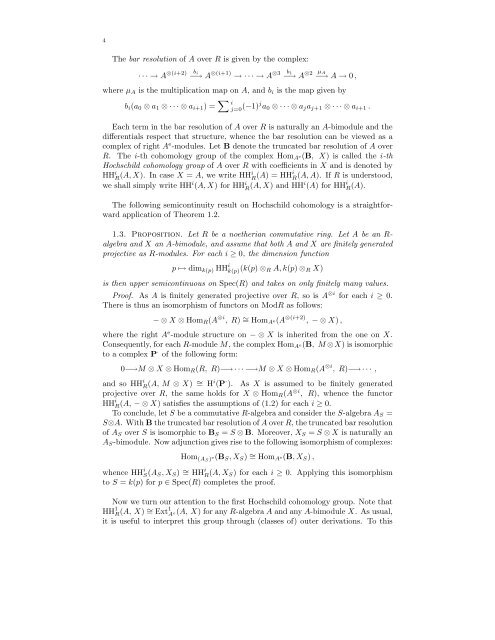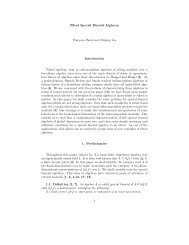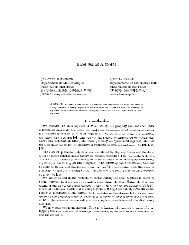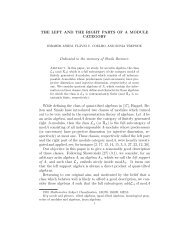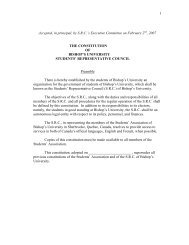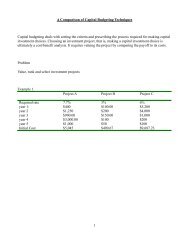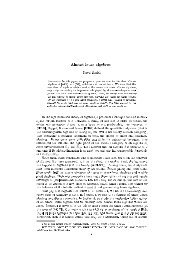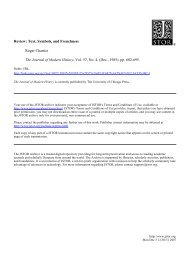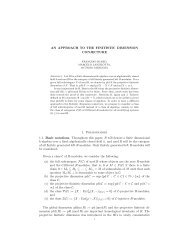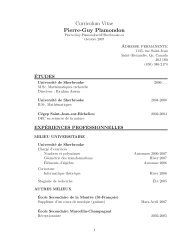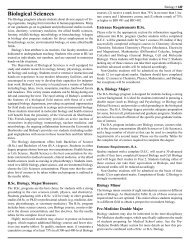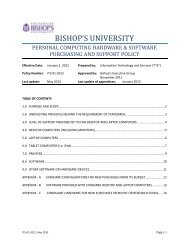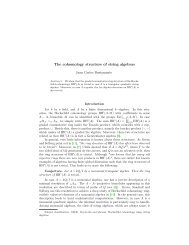Hochschild Cohomology and Representation-finite Algebras Ragnar ...
Hochschild Cohomology and Representation-finite Algebras Ragnar ...
Hochschild Cohomology and Representation-finite Algebras Ragnar ...
Create successful ePaper yourself
Turn your PDF publications into a flip-book with our unique Google optimized e-Paper software.
4<br />
The bar resolution of A over R is given by the complex:<br />
···→A ⊗(i+2)<br />
b<br />
−→<br />
i<br />
A ⊗(i+1) →···→A ⊗3 b<br />
−→<br />
1<br />
A<br />
⊗2<br />
−→ µA<br />
A → 0 ,<br />
where µ A is the multiplication map on A, <strong>and</strong>b i is the map given by<br />
b i (a 0 ⊗ a 1 ⊗···⊗a i+1 )= ∑ i<br />
j=0 (−1)j a 0 ⊗···⊗a j a j+1 ⊗···⊗a i+1 .<br />
Each term in the bar resolution of A over R is naturally an A-bimodule <strong>and</strong> the<br />
differentials respect that structure, whence the bar resolution can be viewed as a<br />
complex of right A e -modules. Let B denote the truncated bar resolution of A over<br />
R. The i-th cohomology group of the complex Hom A e(B, X) is called the i-th<br />
<strong>Hochschild</strong> cohomology group of A over R with coefficients in X <strong>and</strong> is denoted by<br />
HH i R (A, X). In case X = A, wewriteHHi R (A) =HHi R (A, A). If R is understood,<br />
we shall simply write HH i (A, X) forHH i R (A, X) <strong>and</strong>HHi (A) forHH i R(A).<br />
The following semicontinuity result on <strong>Hochschild</strong> cohomology is a straightforward<br />
application of Theorem 1.2.<br />
1.3. Proposition. Let R be a noetherian commutative ring. Let A be an R-<br />
algebra <strong>and</strong> X an A-bimodule, <strong>and</strong> assume that both A <strong>and</strong> X are <strong>finite</strong>ly generated<br />
projective as R-modules. For each i ≥ 0, the dimension function<br />
p ↦→ dim k(p) HH i k(p) (k(p) ⊗ R A, k(p) ⊗ R X)<br />
is then upper semicontinuous on Spec(R) <strong>and</strong> takes on only <strong>finite</strong>ly many values.<br />
Proof. As A is <strong>finite</strong>ly generated projective over R, soisA ⊗i for each i ≥ 0.<br />
There is thus an isomorphism of functors on ModR as follows:<br />
−⊗X ⊗ Hom R (A ⊗i ,R) ∼ = Hom A e(A ⊗(i+2) , −⊗X) ,<br />
where the right A e -module structure on −⊗X is inherited from the one on X.<br />
Consequently, for each R-module M, thecomplexHom A e(B, M⊗X) is isomorphic<br />
toacomplexP· of the following form:<br />
0−→M ⊗ X ⊗ Hom R (R, R)−→···−→M ⊗ X ⊗ Hom R (A ⊗i ,R)−→··· ,<br />
<strong>and</strong> so HH i R (A, M ⊗ X) ∼ = H i (P·). As X is assumed to be <strong>finite</strong>ly generated<br />
projective over R, the same holds for X ⊗ Hom R (A ⊗i , R), whence the functor<br />
HH i R(A, −⊗X) satisfies the assumptions of (1.2) for each i ≥ 0.<br />
To conclude, let S be a commutative R-algebra <strong>and</strong> consider the S-algebra A S =<br />
S⊗A. WithB the truncated bar resolution of A over R, the truncated bar resolution<br />
of A S over S is isomorphic to B S = S ⊗ B. Moreover,X S = S ⊗ X is naturally an<br />
A S -bimodule. Now adjunction gives rise to the following isomorphism of complexes:<br />
Hom (AS) e(B S,X S ) ∼ = Hom A e(B,X S ) ,<br />
whence HH i S(A S ,X S ) ∼ = HH i R(A, X S )foreachi ≥ 0. Applying this isomorphism<br />
to S = k(p) forp ∈ Spec(R) completes the proof.<br />
Now we turn our attention to the first <strong>Hochschild</strong> cohomology group. Note that<br />
HH 1 R(A, X) ∼ = Ext 1 Ae(A, X) for any R-algebra A <strong>and</strong> any A-bimodule X. Asusual,<br />
it is useful to interpret this group through (classes of) outer derivations. To this


